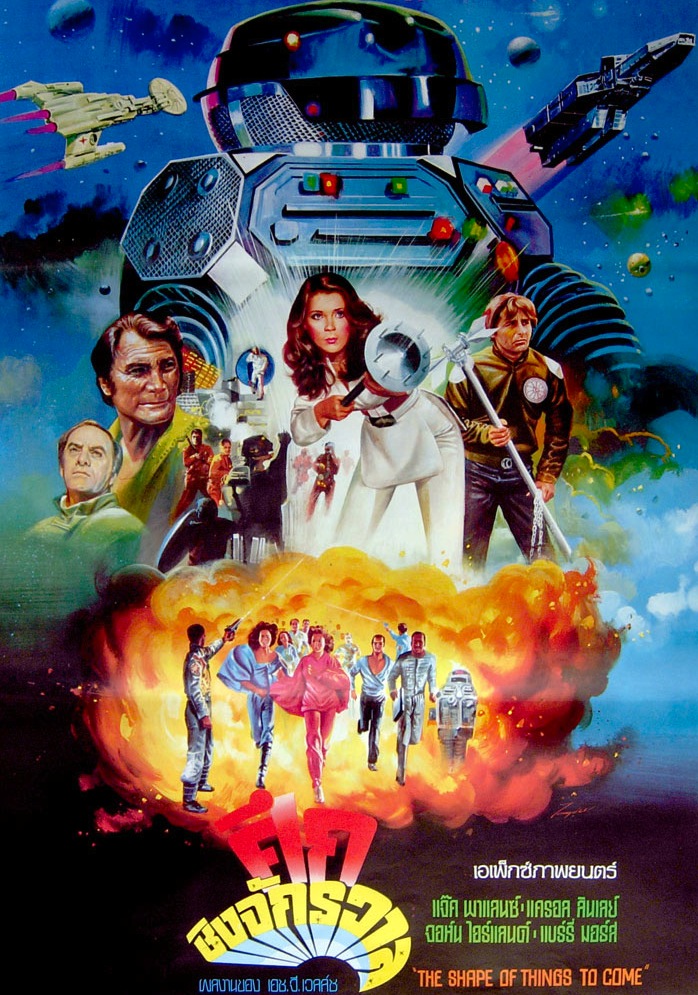Sunday, 13 May, 1979.
THE SHAPE OF THINGS TO COME. Written by Martin Lager, based on an adaptation of the H.G. Wells novel by Mike Cheda and Joseph Glazner. Music by Paul Hoffert. Directed by George McCowan. Running time: 98 minutes. Rated General entertainment.
IN THE MID-1930s, novelist and historian H.G. (for Herbert George) Wells tried his hand at screenwriting. The result was a classic hit of speculative fiction, director William Cameron Menzies's Things to Come (1936).
In an attempt to hitch their fate to that particular star, the producers of The Shape of Things to Come are calling their film a "sequel." The posters outside the theatre go so far as to proclaim the picture H.G. Wells' The Shape of Things to Come.
It's not. Indeed, if Wells were still alive, he could sue for defamation of his literary character. With one or two minor exceptions, the new film is hack work, a picture designed for the post-Star Wars matinee market.
The Earth, we're told in a written prologue, has been wasted by wars, and mankind now lives in New Washington, a domed city on the moon. To survive, it needs a constant supply of RADIC-Q-2, the antidote to radiation sickness.
Apparently, the only source of this miracle mineral is a planet called Delta III. When a renegade scientist named Omus (Jack Palance) seizes control of Delta III, the good guys are in trouble.
New Washington's leader, Senator Smedley (John Ireland) and its master computer, Lomax (voiced by William Hutt), advise against aggressive action. Patriarchal old John Caball (Barry Morse) knows better.
Together with his son, Jason (Nicholas Campbell) and Jason's girlfriend Kim (Eddie Benton), Caball steals an experimental spaceship, the Starstreak, and warps off for Delta III.
Did I tell you about the cute robot?
Kim, a well-groomed young lady with locks that rival those of Farrah Fawcett, has rebuilt one of villain Omus's warrior robots, and programmed it for poetry. It follows her everywhere.
"No, Sparks," she tells it as they're about to leave for Delta III. "You stay here."
"Whither thou goest, I will go," says Sparks (Mark Parr; voice of Greg Swanson).
"He's sort of attached to me," Kim explains to Jason.
"Bring him along," says the prescient young hero. "He may be useful."
Credit for this memorable exchange goes to screenwriter Martin Lager (whose name does not appear on the poster outside the theatre). Together with producer William Davidson, Lager was involved in the creation of CTV's ill-fated Starlost television series (1973).
Direction was provided by George McCowan. Vancouver filmgoers will remember him from his work on the locally-made features The Inbreaker (1974) and Shadow of the Hawk (1976).
As a team, they've managed to create one of the silliest movies of the year.
The above is a restored version of a Vancouver Express review by Michael Walsh originally published in 1979. For additional information on this archived material, please visit my FAQ.
Afterword: Surprisingly, I did not mention in the above review, that the film was made in Toronto. Actress Eddie Benton, whose birth name was Edmonda Benton, is now known professionally as Anne-Marie Martin. Although best known for her starring role in the 1986-1988 comedy cop show Sledge Hammer, the Toronto actress appeared in a 1980 episode of the U.S. TV series Buck Rogers, and was among those who tested for the role of Princess Leia in Star Wars. In Vancouver, where she had a small role in the 1984 feature Runaway, she met its writer-director Michael Crichton. They married in 1987, and later collaborated on the screenplay for the 1996 feature Twister. Nicholas Campbell, who played her Shape of Things to Come inamorata Jason Caball, would also find his way to Vancouver. Campbell is remembered for his work as coroner Dominic Da Vinci during seven seasons of Da Vinci's Inquest (1998-2006), then as Mayor Da Vinci for another season of Da Vinci's City Hall (2005-2006).
See also: In 1979, producer Harry Alan Towers visited Vancouver during the making of the feature Klondike Fever. For my interview with him, click here.
